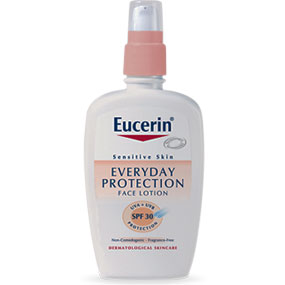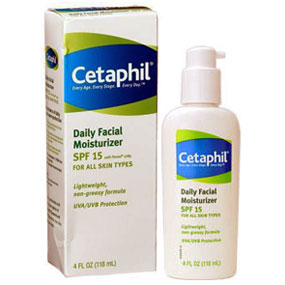
Why Use Moisturizer?
Moisturizer acts as a protective barrier for your skin, keeping it hydrated and healthy. While there tends to be confusion about the need formoisturizer in the first place, most experts recommend using it on a daily basis. In addition to maintaining good diet and managing stress, the Mayo Clinic advises using “a moisturizer that fits your skin type and makes your skin look and feel soft” for an effective skin care regimen.
Learn more about going from sallow to dewy, glowing skin.
Advertisement
What’s Your Skin Type?
A good skin-care regimen includes daily moisturizing and sun protection to fight free radicals and fend off ultraviolet (UV) rays from the sun. The American Academy of Dermatology recommends moisturizing after bathing so that your still-damp skin will seal in moisture.Based on a variety of reasons, including genes and (more manageable) factors like diet, your skin type falls into one of five categories. The most common type in women is combination.
It’s important to know your skin type to make sure you’re putting the right stuff on your face. Very dry skin probably won’t benefit from a water-based product; drier skin will appreciate heavier moisturizers to soak up as much moisture as possible.
Determine your skin type:
- Dry (will benefit from a heavier, oil-based moisturizer)
- Oily (will benefit from lighter, water-based moisturizers)
- Mature (will benefit from oil-based moisturizers to preserve moisture)
- Sensitive (will benefit from soothing ingredients, like aloe, that won’t be harsh on the skin)
- Normal/Combination (will benefit from a lighter, water-based moisturizer)
FDA Guidelines for Cosmetics
What separates a pricey, prettily packaged product from the $10 version found on your local drugstore shelf? Sometimes, not much. Don’t believe that price tags determine quality. It’s the ingredients that matter. A good moisturizer protects you and contains no harmful ingredients.
The
Food and Drug Administration (FDA) doesn’t wield a tight fist over
cosmetics, which makes it tricky to trust which products to use for your
face. While cosmetics don’t have to be FDA-approved to go on the
market, there is a silver lining: the FDA requires manufacturers to list
ingredients on the label “to enable consumers to make informed
purchasing decisions.”
That said, reading the ingredients can be as complex as deciphering ancient Greek. Becoming ingredient-savvy can help you understand what’s in the bottle or jar before you decide to put anything on your face.
Unscented products might include a fragrance as well. To mask unpleasant chemical odors, products may include additional synthetic fragrances that could trigger allergic reactions. Many “natural” ingredients may also be lurking on ingredient labels disguised as fragrances.
That said, reading the ingredients can be as complex as deciphering ancient Greek. Becoming ingredient-savvy can help you understand what’s in the bottle or jar before you decide to put anything on your face.
Fragrance-Free vs. Unscented
Fragrance-free typically means just that: no fragrances have been added to the product. However, even fragrance-free products are not always fragrance free. A natural ingredient or essential oil, acting as a fragrance, might not be listed as such. Many fragrances are synthetic, and mask toxins that could contribute to skin reactions and allergies.Unscented products might include a fragrance as well. To mask unpleasant chemical odors, products may include additional synthetic fragrances that could trigger allergic reactions. Many “natural” ingredients may also be lurking on ingredient labels disguised as fragrances.
Active vs. Inactive Ingredients
Active ingredients, put simply, make the product do what’s it’s intended to do. A moisturizer that blocks UV rays may include titanium oxide, acting as the principal sunscreen agent. The inactive ingredients help out, but they don’t fight the sun’s rays, in this case. Inactive ingredients assist in creating the final product (whether that’s in pill, liquid, or cream form).Non-comedogenic
A product listing this term on the label claims to be non-clogging, or oil-free. Essentially, it means that while the product will break down excess oil, it won’t strip your skin of moisture.Hypoallergenic
Hypoallergenic refers to a product causing less allergic reactions in consumers. Seeing this word on a package, however, doesn’t guarantee a stamp of safety compared with products not marked as hypoallergenic. Since the cosmetic guidelines are not rigid, manufacturers may claim a product to be hypoallergenic—but the FDA doesn’t require manufacturers to provide support for these claims.
So, what can you do? If you’ve had a reaction
from certain ingredients in the past, check the label for these allergic substances—manufacturers
are required by the FDA to list all
ingredients on the packaging.
To cut through the confusion, you can read an overview below of the USDA organic guidelines for certified organic products:
Natural vs. Organic
Natural products use ingredients that come from botanical sources (and may or may not use chemicals). Organic products claim to have ingredients that are grown without chemicals, pesticides, or artificial fertilizers. Unfortunately, the loose FDA guidelines make most products vulnerable to misleading labels, and natural and organic products are not necessarily any better.To cut through the confusion, you can read an overview below of the USDA organic guidelines for certified organic products:
- 100 percent organic: it’s optional, but these products are qualified to use the USDA Organic Seal; products bearing this seal must use organically-produced ingredients (not counting water and salt).
- Organic: products marked “organic” contain at least 95 percent organic ingredients (not counting water and salt) and can display the Organic Seal; as for the rest of the ingredients, they must be from approved, non-agricultural substances, or from non-organically produced agricultural products.
- Made with organic ingredients: contains at least 70 percent organic ingredients but products cannot use the USDA Organic Seal; these products are allowed to list “up to three of the organic ingredients or ‘food’ groups on the principal display panel.”
- Less than 70 percent organic ingredients: products cannot use the organic seal or use the word “organic” anywhere on the main product package (organically produced ingredients can be listed).
Broad-Spectrum
This means that the product blocks both UVB and UVA rays from the sun. While not all moisturizers contain sunscreen, many products now offer this two-in-one blend. If you don’t use a moisturizer that fights the sun’s rays, apply your moisturizer first then follow up with sunscreen.Parabens
Parabens are preservatives that give cosmetics a longer shelf life. On the label, you may see these commonly used parabens in cosmetics: methylparaben, propylparaben, and butylparaben, all deemed “safe for use in cosmetic products at levels up to 25 percent” according to The Cosmetic Ingredient Review (CIR).
Used
in a variety of beauty and skin care products, parabens have been studied for
their potential health risks, based on concerns that they mimic estrogen, which
in turn could lead to cancer. Since parabens are not listed on the USDA
National Organic Program (NOP) list, they may still be included in products
marked as organic.
Currently, the FDA maintains that parabens do not pose a serious health risk to require their removal from cosmetic products. Based on studies, the FDA claims, “Although parabens can act similarly to estrogen, they have been shown to have much less estrogenic activity than the body’s naturally occurring estrogen.” Parabens are considered safe at low levels, according to the CIR, ranging from 0.01 to 0.3 percent in cosmetics.
Currently, the FDA maintains that parabens do not pose a serious health risk to require their removal from cosmetic products. Based on studies, the FDA claims, “Although parabens can act similarly to estrogen, they have been shown to have much less estrogenic activity than the body’s naturally occurring estrogen.” Parabens are considered safe at low levels, according to the CIR, ranging from 0.01 to 0.3 percent in cosmetics.
Phthalates
Phthalates are found among a wide variety of products—from fragrances, lotions, and deodorants to toys and food packaging—and have raised concern about potential health risks, including impaired fertility. Due to increasing public anxiety, progress was made to push for testing and federal regulation. A 2008 follow-up study by the Campaign for Safe Cosmetics showed that a portion of the cosmetics industry has lowered its use of phthalates in products. This widely used and widely researched chemical has been studied mainly in rodents, and in limited volunteer studies in humans. According to the American Chemistry Council, findings suggest that cancer-causing concerns in phthalates are more unique to rodents than to humans. Reports by the U.S. National Toxicology Program on six of the seven phthalates that it reviewed found the risk to human reproductive and developmental health to be “minimal."Product Review
It can be tough to wade through the dizzying list of ingredients to figure out which products are safest for your skin. To help your search, Healthline tested the options available at pharmacies and supermarkets, and had dermatologist Dr. Judith Hellman of the Mt. Sinai Hospital weigh in. Read our recommended facial moisturizer list.For Sensitive Skin

Healthline Recommends: Eucerin Everyday Protection Face Lotion SPF 30 for Sensitive Skin
Male and female testers hailed this silky smooth, fragrance-free lotion that also contains zinc oxide and titanium dioxide for sunscreen protection. Light enough for sensitive skin, strong enough to block the sun’s rays, the creamy texture blends well for long-lasting coverage.
Runner Up: Lightweight Moisturizer
 Healthline Recommends:
Alba Botanica Aloe
& Green Tea Oil-Free Moisturizer
Healthline Recommends:
Alba Botanica Aloe
& Green Tea Oil-Free Moisturizer Though geared toward all skin types, this lightweight, refreshing formula containing the certified organic ingredients aloe vera, green tea, and humectants (which attract moisture), is gentle enough for skin types that can’t handle thicker moisturizers. Said one tester, “it’s not glunky or sticky, and once you rub it in, you can’t tell it’s there.”
For Dry Skin
 Healthline
Recommends: Neutrogena
Intensified Day Moisture SPF 15
Healthline
Recommends: Neutrogena
Intensified Day Moisture SPF 15Ultra dry skin will soak up this moisturizer that doubly hydrates and offers sun protection using titanium dioxide. Said one tester of this nourishing and “definitely intense” formula, “Several hours into the day my face was still smooth.”
For Combination/Oily Skin

Healthline Recommends: Yes to Tomatoes Daily Balancing Moisturizer
Packed with (key ingredients) organic tomatoes, red tea, and watermelon, this sweet-smelling formula seeps into skin for a lightweight, dewy finish. Results are immediate. The formula balances oily-prone skin, revealing a radiant glow.
For Mature Skin
 Healthline Recommends:
Olay
Regenerist UV Defense Regenerating Lotion with SPF 50
Healthline Recommends:
Olay
Regenerist UV Defense Regenerating Lotion with SPF 50Potent and powerful, this thick yet silky cream also offers intense sunscreen protection. The formula hydrates, using a blend of anti-inflammatory and anti-aging ingredients to soothe and tone skin, and protects, using broad spectrum SPF 50 to block UV rays.
For Women
 Healthline Recommends:
Burt’s
Bees Radiance Day Lotion SPF 15
Healthline Recommends:
Burt’s
Bees Radiance Day Lotion SPF 15Created with royal jelly to renew and rejuvenate, this thin formula was praised for going on “smooth and silky.” The lightweight lotion provides a great base before applying foundation, plus titanium dioxide and zinc oxide provide UVA/UVB protection. Said one tester, “The SPF coverage may not be enough for a day at the beach, but it’s great for everyday protection.”
For Men
 Healthline Recommends:
Neutrogena
Men Sensitive Skin Oil-Free Moisture SPF 30
Healthline Recommends:
Neutrogena
Men Sensitive Skin Oil-Free Moisture SPF 30Great for days at the beach. Though not waterproof, this lightweight moisturizer with SPF locks in moisture and blocks UV rays to keep you looking young. Said one tester, “It feels lightweight, and doesn’t irritate even the most sensitive of skin.”
For Everyone
 Healthline Recommends:
Cetaphil
Daily Facial Moisturizer with SPF 15
Healthline Recommends:
Cetaphil
Daily Facial Moisturizer with SPF 15Noted one tester, “I tend to forget about putting sunscreen on, but I’m much better at remembering to moisturize.” This two-in-one formula did have a slight sunscreen smell; but the lightweight moisturizer was gentle and refreshing. Though for longer days in the sun, you might want to reapply for ultimate coverage.
No comments:
Post a Comment